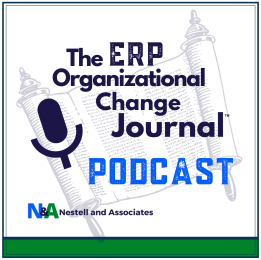ERP system selection is critical. Whether a success or failure, ERP change is challenging and can be highly disruptive.
How to Select an ERP System
Proper ERP system selection is a critical first step toward digital transformation and ERP organizational change success. Whether an ERP vendor, ERP 3rd party reseller, ERP 3rd party implementer, ERP researcher, ERP practitioner/SME, experienced PE executive, or especially organizational stakeholders, the facts are well known: ERP organizational changes success (and of course failure) can be highly disruptive.
Of course, many ERP organizational efforts are successful or eventually successful and, some are not. Some organizations are eventually successful despite significant challenges and expenditure of time, money, and effort. Being unsuccessful does not just mean pending lawsuits. While lawsuits are not uncommon and while there is a demand for ERP expert witness services, “lawsuits” and “expert witness” services are not necessarily included in the definition of success or failure. At least, we have never seen an organization’s definition of success that reads “Prevent a lawsuit”.
A typical definition of success is defined as, or includes;
- being on time
- being on budget
- meeting all functionality expectations
- and/or being perceived by the organization as a success.
Sound research, case studies, anecdotal evidence, vendor-neutral 3rd party research, and reviewing lawsuits (that are made public and not settled) provide ample evidence that whether a success or failure, ERP change is challenging and can be disruptive.
Setting Honest and Realistic Expectations During ERP System Selection
As the old adage goes, “Honesty is the best policy”. ERP organizational change comes with no magic wands, crystal balls, or any other form of wizardry. Setting inaccurate, false, misleading, or dishonest expectations of the work, realities, statistics, and potential challenges that lay ahead during an ERP organizational change is a disservice to organizational stakeholders.
“It can be difficult to ‘hope for the best but prepare for the worst’ if the organization is unaware of the potential challenges.” -Dr. Jack Nestell
By being aware of, acknowledging, and then accepting the realities of potential disruption and challenges, organizations would have the opportunity to be more prepared simply by virtue of improved awareness and wanting to address and detour potential issues as much as possible.
The reason that setting honest and realistic expectations is critical: Honesty and transparency are a part of the cure and certainly the prevention. The goal of honesty and transparency is not to create fear or reservation, not at all, but to endorse success.

The reason that setting honest and realistic expectations is critical: Honesty and Transparency are a part of the cure and certainly the prevention. The goal of honesty and transparency is not to create fear or reservation, not at all, but to endorse success.
ERP System Selection Criteria
-
- Noudoostbeni, Ismail, Jenatabadi, Yasin, (2010): “…due to high rate of difficulties and failures in implementing the ERP systems, as explained in the review of literature, it can cause some disorders (Jafari, Osman, Yusuf, & Tang, 2006). Therefore, there are many companies that, due to the high failure rate, are not successful in their ERP implementation projects (Trunick, 1999).”
- Sobky and Hadi (2015): “The implementation of such systems is a complex process, and the failure rate remains very high.”
- Wamba, Kamdjoug, Akter, & Carillo (2018): “However, despite the promise of a high operational and strategic impact (if a sound business process analysis is performed), it remains challenging to easily familiarize with the use of ERPs (in order to manage computerized data exchanges) and to integrate software packages within them. As a result, ERPs have gradually become an important focus for a number of academic and corporate investigations over the past two to three decades.”
- Antoniadis, Tsiakiris, & Tsopoglot (2015): “Our results indicate that although SMEs recognize the advantages and benefits gained by the application of these systems, especially in managing and summarizing heterogeneous data, still the business intelligence capabilities of ERP systems are underutilized, as managers do not take advantage of the knowledge and experience gained from using them.”
- Bajwa, Garcia, & Mooney (2016): “If case studies are any indication of the outcomes in ERP investment, insights already suggest that many attempts have not delivered the expected benefits, have failed completely, or will have high probability of failure”.
- Stratman and Roth (2018): “To improve responses to changes in markets and products, manufacturers are increasingly adopting ERP systems. However, anecdotal accounts indicate that the realization of ERP’s potential benefits is rare.”
- Shao, Feng, & Hu (2017): “Extant literature suggests that few companies have fully appropriated the expected benefits from their ERP systems AND However, spectacular ERP failures are frequent.”
When Selecting an ERP System, Start with these three Steps
-
- Ask how do they define ERP organizational change success?
- Ask what percent of projects are successful?
- Determine if steps 1 and step 2 correlate. Success needs to be clearly defined and described. Else, it can be subjective and open to interpretation, assumptions, and misguided and misunderstood expectations.
We are not stating that all ERP organizational change efforts are failures, clearly, that is not the case at all. What we are simply stating is that often the true realities and expectations of large-scale ERP organizational change can often go unrecognized and unacknowledged from the stakeholders from the onset of a project. And what we are also simply stating is that ERP organizational change can be challenging, present many risks, and be highly disruptive. The key is to recognize this truth and to build tactical items in the project plan to address critical success influences.
If success is defined as on-time, on-budget, delivery of all functionality as outlined in scope, and/or all organizational stakeholders would describe the effort as successful, and then if a vendor’s answer is “100% success”, perhaps probe deeper.
Whether the largest of global ERP vendors, smallest of ERP niche vendors, “Big10” accounting firms, or small 3rd party partner VARs (value-added resellers) and implementers, there is ample evidence in the form of;
-
- case studies,
- formal and informal surveys,
- law firms and expert witnesses,
- news articles,
- U.S. Securities and Exchange Commission submissions, etc.,
that the truth is that ERP organizational change can be challenging. We know that formal studies of even “successful” ERP organizational change indicate a significant amount of challenge.
Of course, there are successful projects but the more organizations recognize and understand this truth from the beginning, the more prepared they can be.
A Vendor Selection Process Case Study
In a vendor selection process, five vendors were evaluated and asked to complete a Market Data survey. The Market Data survey consisted of 97 questions within nine major categories including Corporate Profile, Financial Profile, Product Strategy, Implementation, Training Services, Support Services, Pricing, Customer Base, and User Group.
Within the Market Data survey, some of the questions are useful not necessarily to learn what is already known, but to get a sense of honesty and transparency. That is, the real reason why professional firms that research, study, and provide selection services ask certain questions is to gauge transparency and honesty. The selection is crucial and there has to be a way to measure some degree of potential partner transparency. The below questions included in the Market Data survey assist in gauging partner selection transparency and honesty.
Market Data Questions Which Provide Insight into Honesty and Transparency
A review of the questions:
1) Methodology for implementation services:
*NOTE: Not often will the sales cycle include “well, our methodology is OK”, or “We have a solid methodology that works but we still have challenges and business disruption”, or “We are changing our methodology to improve our process”, etc. Instead, you will get “Proven”, “State of the Art”, and “World Class”.
2) Number of successful lawsuits within the past three years (publicly listed litigation claims):
*NOTE: If a large global player. They have or have had public lawsuits. Lawsuits are not necessarily bad, not being honest is bad.
3) Total value in US dollars of successful lawsuits within the past three years:
4) Number of pending lawsuits (publicly listed litigation claims):
*NOTE: “Publicly” doesn’t include privately settled.
5) Total value in US dollars of pending lawsuits:
6) What percent of your training clients may be referenced?
*NOTE: In “A Qualitative Study of Risk Mitigation in Enterprise Resource Planning Implementations”, Dr. Goldston notes that:
“Given the vendor will only provide customers that will praise their product (additionally, these customers normally receive some incentive from the vendor), the visiting organization should prepare a list of questions to ask during this visit <or calls> to get an indication of the system‘s true capabilities and drawbacks”.
Therefore, the question isn’t “may we have references”, the question is specifically “What percent of your support services customers may be referenced?”
7) What percent of your support services customers may be referenced?
Vendor Feedback
Vendor #1:
-
- Methodology for implementation services: “Our proven implementation methodology is….”
- Number of successful lawsuits within the past three years (publicly listed litigation claims): <left blank>
- Total value in US dollars of successful lawsuits within the past three years: <left blank>
- Number of pending lawsuits (publicly listed litigation claims): <left blank>
- Total value in US dollars of pending lawsuits: <left blank>
- What percent of your training clients may be referenced? “All customers have a need for training their organization, from a customer reference perspective, it is a question that should be addressed on reference calls.”
- What percent of your support services customers may be referenced? “Further discussion is required with particular support customers (as with any reference). This information is not available at this time.”
Vendor #2:
-
- Methodology for implementation services: “implementation methodology ensures immediate customer satisfaction while getting customers to go-live quickly… rapid deployment, ensuring ROI is realized rapidly.”
- Number of successful lawsuits within the past three years (publicly listed litigation claims):“<removed> does engage in litigation in the normal course of business. <Removed> does not comment on pending claims and/or litigation; however, <Removed> is a public company and, as such, reports all litigation and/or legal claims that may have a material, adverse effect on the operation of its business in its Form 10-K filings and any subsequent updates with the Securities and Exchange Commission. <Removed> Form 10-K can be found at the following site: <removed>.”
- Total value in US dollars of successful lawsuits within the past three years: “Please refer to the response above.”
- Number of pending lawsuits (publicly listed litigation claims): “Please refer to the response above.
- Total value in US dollars of pending lawsuits: “Please refer to the response above.”
- What percent of your training clients may be referenced? “As noted above, should we be selected as a finalist in your process, we would be pleased to provide you with references that are tailored to your needs.” (This comment deserves conversion for multiple reasons. References are to assist on the final selection process.)
- What percent of your support services customers may be referenced? “As noted above, should we be selected as a finalist in your process, we would be pleased to provide you with references that are tailored to your needs.” What? This is backward. References are top assist on the final selection process.
Vendor #3:
-
- Methodology for implementation services: “Our proprietary implementation methodology will provide a collaborative, proven framework…”
- Number of successful lawsuits within the past three years (publicly listed litigation claims) : “As with any large commercial enterprise, over the course of a lengthy history, there have been contract disputes. Where such disputes arise, <Removed> standard procedure is to achieve an amicable resolution by directing its efforts to resolve disputes through communication and dialogue.”
- Total value in US dollars of successful lawsuits within the past three years: “Please see our response to 2.2.3.”
- Number of pending lawsuits (publicly listed litigation claims) “Please see our response to 2.2.3.”
- Total value in US dollars of pending lawsuits: “Please see our response to 2.2.3.”
- What percent of your training clients may be referenced? “Reference customers are available upon request.” That is understood but that was not the question.
- What percent of your support services customers may be referenced? “ Reference customers are available upon request.” That is understood but that was not the question.
Vendor #4:
-
- Methodology for implementation services: “world-class implementation tools,”
- Number of successful lawsuits within the past three years (publicly listed litigation claims): “0”.
- Total value in US dollars of successful lawsuits within the past three years: “NA”
- Number of pending lawsuits (publicly listed litigation claims): “0”
- Total value in US dollars of pending lawsuits: “NA”
- What percent of your training clients may be referenced? “~97%”. Honest Answer?
- What percent of your support services customers may be referenced? “94%”. Honest Answer?
Vendor #5:
-
- Methodology for implementation services: “Implementation methodology depends on the customer and partner’s preference. Most partners will offer T&M or Fixed Price depending on customer’s requirements and desired outcomes.”
- Number of successful lawsuits within the past three years (publicly listed litigation claims): “<Removed> is subject to legal proceedings and claims, either asserted or unasserted, which arise in the ordinary course of business. Details of such litigation can be found in filings made with the SEC which are publicly accessible through the SEC’s EDGAR database on the Internet.”
- Total value in US dollars of successful lawsuits within the past three years:”<Removed> is subject to legal proceedings and claims, either asserted or unasserted, which arise in the ordinary course of business. Details of such litigation can be found in filings with the SEC which are publicly accessible through the SEC’s EDGAR database on the Internet”
- Number of pending lawsuits (publicly listed litigation claims)” <Removed> is subject to legal proceedings and claims, either asserted or unasserted, which arise in the ordinary course of business. Details of such litigation can be found in filings with the SEC which are publicly accessible through the SEC’s EDGAR database on the Internet”
- Total value in US dollars of pending lawsuits: “<Removed> is subject to legal proceedings and claims, either asserted or unasserted, which arise in the ordinary course of business. Details of such litigation can be found in filings with the SEC which are publicly accessible through the SEC’s EDGAR database on the Internet”
- What percent of your support services customers may be referenced? <left blank>
- What percent of your training clients may be referenced? <left blank>
The Moral of the Story of ERP System Selection and Implementation
No question, there are great ERP products and their 3rd party implementers available to organizations. But that is only a part of the ERP system and partner selection consideration. For the benefit and value of the organizations, simply being honest about what the organization is about to initiate, endure, and ultimately accomplish is significant.
When ERP vendors and partners are honest, it will make the ERP sales cycle appear more knowledgeable and reliable in terms of ERP organizational change, create respect with organizations, and strengthen vendor-client relationships.
Organizations need to hear that ERP partners acknowledge implementation challenges are highly disruptive in nature to large-scale ERP organization change. ERP partners need honest about the realities, expectations, and challenges and they need to demonstrate professionalism with honesty and by illustrating their proactive, detailed, and tactical plan for countering challenges when they do arise.
This is what organizations not only want to hear but need to hear. – Proper ERP system selection starts with honesty and transparency. Proper ERP selection requires knowledge of the critical success factors, experience, and expertise.
Nestell & Associates Can Help Put the Benefits of an ERP System to Work for Your Business
At Nestell & Associates, we offer a wide range of consulting services that can help you take your business to the next level. Whether you need an ERP project management plan or a full-scale digital transformation, we can put your company on the path to success. Contact us today to find out how.
Authored By
Dr. Jack G. Nestell
Related Podcast
Episode 62: Industry 4.0: MES and OEE Value Proposition
In this episode, we dive into Manufacturing execution systems (MES), Overall Equipment Effectiveness (OEE), and Industry 4.0. with Oskar Schwarz of FACTIVITY. We discuss one specific MES manufacturer’s approach to successful assimilation. We explore the value proposition of MES, Industry 4.0, OEE, technologies driving Industry 4.0., ERP and MES integration, OEE and MES myths and mistakes, the Internet of Things (IoT), and the definition of MES success, MES differentiators, and more.
Related Articles
About Nestell & Associates
Nestell & Associates is a strategy and management firm. We can help you take your portfolio companies to the next level by demonstrating how to execute a scalable, methodical, and disciplined approach to digital transformation success.
Merger and acquisition ERP digital transformations can be a significant challenge. But a solid framework is built on good practices with proven success. We have a successful track record with integrations, upgrades, mergers, and acquisitions, and we want to share our methods with you.
Our leadership experience in organizational change, information technology, ERP, and digital transformation crosses multiple industries.





